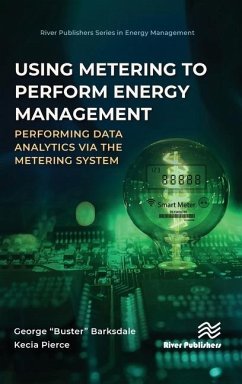Barksdale, Kecia Pierce
Using Metering to Perform Energy Management
Performing Data Analytics Via the Metering System
Barksdale, Kecia Pierce
Using Metering to Perform Energy Management
Performing Data Analytics Via the Metering System
- Gebundenes Buch
- Merkliste
- Auf die Merkliste
- Bewerten Bewerten
- Teilen
- Produkt teilen
- Produkterinnerung
- Produkterinnerung
This book will cover many helpful analysis tools and processes to help energy managers administer their energy program through their meter management system.
Andere Kunden interessierten sich auch für
![Behavioural Types Behavioural Types]() Behavioural Types114,99 €
Behavioural Types114,99 €![Engineering Agile Big-Data Systems Engineering Agile Big-Data Systems]() Engineering Agile Big-Data Systems125,99 €
Engineering Agile Big-Data Systems125,99 €![Blockchain in Energy Blockchain in Energy]() Blockchain in Energy154,99 €
Blockchain in Energy154,99 €![Advanced Data Acquisition and Intelligent Data Processing Advanced Data Acquisition and Intelligent Data Processing]() Advanced Data Acquisition and Intelligent Data Processing155,99 €
Advanced Data Acquisition and Intelligent Data Processing155,99 €![Mathematical and Computational Modelling of Covid-19 Transmission Mathematical and Computational Modelling of Covid-19 Transmission]() Mathematical and Computational Modelling of Covid-19 Transmission146,99 €
Mathematical and Computational Modelling of Covid-19 Transmission146,99 €![Energy Security Energy Security]() Energy Security114,99 €
Energy Security114,99 €![Use of AI, Robotics, and Modern Tools to Fight Covid-19 Use of AI, Robotics, and Modern Tools to Fight Covid-19]() Use of AI, Robotics, and Modern Tools to Fight Covid-19130,99 €
Use of AI, Robotics, and Modern Tools to Fight Covid-19130,99 €-
-
-
This book will cover many helpful analysis tools and processes to help energy managers administer their energy program through their meter management system.
Hinweis: Dieser Artikel kann nur an eine deutsche Lieferadresse ausgeliefert werden.
Hinweis: Dieser Artikel kann nur an eine deutsche Lieferadresse ausgeliefert werden.
Produktdetails
- Produktdetails
- Verlag: River Publishers
- Seitenzahl: 394
- Erscheinungstermin: 12. April 2024
- Englisch
- Abmessung: 234mm x 156mm x 24mm
- Gewicht: 771g
- ISBN-13: 9788770228381
- ISBN-10: 8770228388
- Artikelnr.: 69935993
- Herstellerkennzeichnung
- Libri GmbH
- Europaallee 1
- 36244 Bad Hersfeld
- gpsr@libri.de
- Verlag: River Publishers
- Seitenzahl: 394
- Erscheinungstermin: 12. April 2024
- Englisch
- Abmessung: 234mm x 156mm x 24mm
- Gewicht: 771g
- ISBN-13: 9788770228381
- ISBN-10: 8770228388
- Artikelnr.: 69935993
- Herstellerkennzeichnung
- Libri GmbH
- Europaallee 1
- 36244 Bad Hersfeld
- gpsr@libri.de
Buster Barksdale is a Mechanical Engineer who is a Certified Energy Manager with over 44 years of energy management experience and has served at all organizational and functional levels. His service started in 1978 as an Energy Manager for the US Air Force. Since then, he has performed engineering, energy management, construction management, performance contracts, facility operations and consulted on government energy policy and procurement procedures. His experiences in the Air Force led him to evaluate and inspect maintenance for 20 installations, which developed into a study that revised how the Air Force performed maintenance. Upon retiring from the Air Force, he continued in all aspects of energy management with a specific emphasis on control systems and the development of analysis techniques. For 25 years, he has applied the techniques he learned in the Air Force to incorporate best maintenance practices into a monitoring commission with meters and control systems. This experience has been poured into the Army metering program, which has developed analysis tools that the energy managers could use to do their job easier and better. Over 45 tools have been developed, with five additional in development. The professional development program led by Buster and Kecia Pierce received the International Energy Professional Develop Award for the Association of Energy Engineers in 2019. Buster is a CEM, CSDP, CDSM, Fellow Society of American Military Engineers, Fellow Association of Energy Engineers (AEE), Hall of Fame AEE, Past President of AEE, Board of Directors AEE. Kecia Pierce is a Software Scientist and Project Manager who has over 33 years of requirements analysis, structured design, product/project management, and implementation leadership experience, thus giving her a strong technical background and a solid understanding of geospatial energy infrastructure management systems, including Outage and Incident Management. Kecia has worked with over 170 utilities and communications companies worldwide, leading to an in-depth knowledge of requirements and supporting technology in the energy geospatial software industry. Kecia has been published in various industry magazines and publications, such as Transmission and Distribution World, GeoWorld, and Geospatial Today. Kecia is a Project Management Institute Certified Project Management Professional, and has served with Energy Huntsville, GEO Huntsville, the GITA conference committee, and the GITA Board of Directors. Kecia has served as the Outreach Strategist for the US Army's Meter Data Management System (MDMS) since October 2016. She provides the services of a communications strategist, technical writer, and trainer for educating US Army Energy Managers in using the MDMS to prioritize their energy conservation actions, and verify energy savings. Kecia prepares and leads the MDMS training webinars, tutorials, and the MDMS Update newsletter that notifies the Army end-user community of advancements, changes, and other pertinent facts about the Army Meter Program.
1. Introduction
2. What is Important about Managing Meter Systems?
3. Fault Detection
4. Comprehensive Building Analytics (HVAC Systems)
5. Setting up Billing
6. Meter Data Connectivity
7. Data Quality
8. Auditing Template
9. Using Metering for Measurement & Verification (M&V)
10. Basic Benchmarking (1st level)
11. Second Level Benchmarking (Baseload with Plug load)
12. Third Level Benchmarking (Lights and Scatter Plot Modeling)
13. Fourth Level of Benchmarking (Fan/Pump and AC Systems)
14. Understanding and Troubleshooting System Overrides
15. Monitoring Commissioning (MCx) Process
16. Evaluating the Energy Use Intensity (EUI) Value to the Energy Manager
17. Comparing EUI to Other Metrics
18. Setting Up for Energy Projects
19. Comparing Campus Consumption to Individual Building Statistics
20. Cross-referencing 3 Metrics for Evaluating Buildings
Appendixes
1. The Transition of HDD and CDD Over the Last 70 Years
2. Determine the Impact of Variance on Calculating Various Degree Day Base
Temperatures
3. Determine the Variance of Each Energy System in the Scatter Plot and the
Overall Impact
2. What is Important about Managing Meter Systems?
3. Fault Detection
4. Comprehensive Building Analytics (HVAC Systems)
5. Setting up Billing
6. Meter Data Connectivity
7. Data Quality
8. Auditing Template
9. Using Metering for Measurement & Verification (M&V)
10. Basic Benchmarking (1st level)
11. Second Level Benchmarking (Baseload with Plug load)
12. Third Level Benchmarking (Lights and Scatter Plot Modeling)
13. Fourth Level of Benchmarking (Fan/Pump and AC Systems)
14. Understanding and Troubleshooting System Overrides
15. Monitoring Commissioning (MCx) Process
16. Evaluating the Energy Use Intensity (EUI) Value to the Energy Manager
17. Comparing EUI to Other Metrics
18. Setting Up for Energy Projects
19. Comparing Campus Consumption to Individual Building Statistics
20. Cross-referencing 3 Metrics for Evaluating Buildings
Appendixes
1. The Transition of HDD and CDD Over the Last 70 Years
2. Determine the Impact of Variance on Calculating Various Degree Day Base
Temperatures
3. Determine the Variance of Each Energy System in the Scatter Plot and the
Overall Impact
1. Introduction
2. What is Important about Managing Meter Systems?
3. Fault Detection
4. Comprehensive Building Analytics (HVAC Systems)
5. Setting up Billing
6. Meter Data Connectivity
7. Data Quality
8. Auditing Template
9. Using Metering for Measurement & Verification (M&V)
10. Basic Benchmarking (1st level)
11. Second Level Benchmarking (Baseload with Plug load)
12. Third Level Benchmarking (Lights and Scatter Plot Modeling)
13. Fourth Level of Benchmarking (Fan/Pump and AC Systems)
14. Understanding and Troubleshooting System Overrides
15. Monitoring Commissioning (MCx) Process
16. Evaluating the Energy Use Intensity (EUI) Value to the Energy Manager
17. Comparing EUI to Other Metrics
18. Setting Up for Energy Projects
19. Comparing Campus Consumption to Individual Building Statistics
20. Cross-referencing 3 Metrics for Evaluating Buildings
Appendixes
1. The Transition of HDD and CDD Over the Last 70 Years
2. Determine the Impact of Variance on Calculating Various Degree Day Base
Temperatures
3. Determine the Variance of Each Energy System in the Scatter Plot and the
Overall Impact
2. What is Important about Managing Meter Systems?
3. Fault Detection
4. Comprehensive Building Analytics (HVAC Systems)
5. Setting up Billing
6. Meter Data Connectivity
7. Data Quality
8. Auditing Template
9. Using Metering for Measurement & Verification (M&V)
10. Basic Benchmarking (1st level)
11. Second Level Benchmarking (Baseload with Plug load)
12. Third Level Benchmarking (Lights and Scatter Plot Modeling)
13. Fourth Level of Benchmarking (Fan/Pump and AC Systems)
14. Understanding and Troubleshooting System Overrides
15. Monitoring Commissioning (MCx) Process
16. Evaluating the Energy Use Intensity (EUI) Value to the Energy Manager
17. Comparing EUI to Other Metrics
18. Setting Up for Energy Projects
19. Comparing Campus Consumption to Individual Building Statistics
20. Cross-referencing 3 Metrics for Evaluating Buildings
Appendixes
1. The Transition of HDD and CDD Over the Last 70 Years
2. Determine the Impact of Variance on Calculating Various Degree Day Base
Temperatures
3. Determine the Variance of Each Energy System in the Scatter Plot and the
Overall Impact








